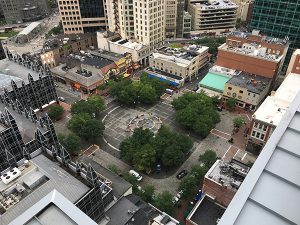
Latest News
-
Students Explore Fabric of Historic Pittsburgh Through “Experiencing Architecture” Program
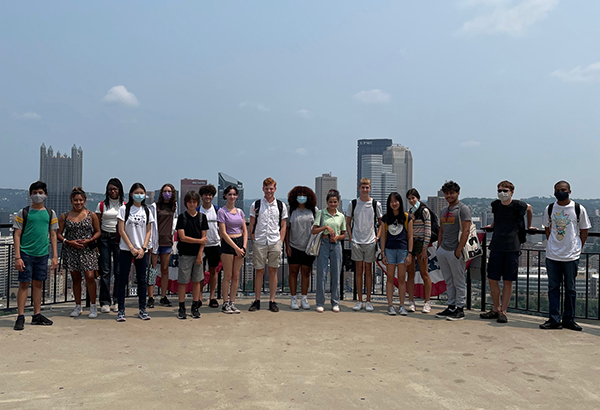
Students from the University of Pittsburgh’s “Experiencing Architecture,” summer studio program (pictured here on Mount Washington) learned how to read the built environment from PHLF co-directors of education Tracy Myers and Sarah Greenwald over three afternoons in July.
A group of high school students spent three afternoons in July exploring the historic built environment of our city and region with the directors of our education team, as part of a four-week architectural studio program funded by the University of Pittsburgh’s Architectural Studies Program.
Tracy Myers and Sarah Greenwald, co-directors of our organization’s education department, guided the group on an exploration of the history and place, looking at how culture is reflected in our shared built environment, and how architecture and the principles of historic preservation in a city contribute to the aesthetics of our city neighborhoods, Downtown, and main street communities. As part of the tours, the students also learned about concepts of historic preservation as a tool of economic revitalization and community development.
The program was funded by the University of Pittsburgh’s Architectural Studies Department, which was awarded a seed grant from the Office of the Chancellor at the University of Pittsburgh to develop a summer architectural studio program for high school students. The four-week program took place in July.
“We are glad to work with community partners such as the Pittsburgh History & Landmarks Foundation to deepen students’ understanding and appreciation of the diverse array of landmark architecture found in Pittsburgh,” said program coordinator Sara Pettit.
“Getting out of the studio and into the real world is always important for students of architecture, regardless of their age or level of interest. Carefully studying buildings and their relationships to other elements of the built environment is absolutely essential to the design process, as is understanding that buildings embody lives and histories; they aren’t mere piles of material,” said Tracy Myers.
“Sarah and I were delighted to share our city’s rich architectural legacy with these sharp young people and explain to them how preservation continues to inspire and invigorate our communities,” she added.
If you are interested in having PHLF collaborate with you to enrich your education program, contact us at sarahg@phlf.org or tracy@phlf.org. For questions about The University of Pittsburgh’s “Experiencing Architecture” summer studio course, email stp85@pitt.edu.
-
Historic Tour of Downtown Pittsburgh: A Fresh Perspective

Looking like so many stars set against the night sky, this image of the skylight at the center of The Pennsylvanian’s rotunda is seen from the perspective of writer Emily Barrie, during her recent exploration of Downtown Pittsburgh’s landmark architecture.
The following article was written by Emily Barrie, a tenth-grade student at Upper St. Clair School High School in Allegheny County. The idea for this article originated when Emily called our offices to express her interest in learning more about the historic built environment and volunteering for PHLF. Because of the Covid-19 pandemic, our staff was working from home at the time. We suggested that Emily explore Downtown Pittsburgh using our guidebook, “Exploring Pittsburgh,” and then write about her experience. Her fresh perspective highlights the enduring vitality of our city’s architecture, no matter the time or circumstances. To explore on your own this summer, please order one of our guidebooks at https://phlf.org/landmarks-store/ or download a self-guided tour at https://phlf.org/education-department/self-guided-walking-tours/.
Since 2020, our world has gone through a chaotic and challenging time due to the Covid-19 global pandemic, which led to the closure of many of our favorite buildings and businesses. Still, there are many exciting places to visit right in our very own city that can fulfill your need to leave the house. I have always loved history in general, but discovering the history and culture of my own city has been especially rewarding. This past year, I toured Downtown Pittsburgh’s historic landmarks, including The Pennsylvanian, buildings in the Cultural District and Market Square, Smithfield United Church, Point State Park, and the Omni William Penn Hotel.
Regardless of their status on tourist destination lists, the sites showed me, as a Pittsburgh-area resident, an underappreciated and beautiful side of my city— one I hope more people take the time to learn about.
 The first landmark I visited was The Pennsylvanian, historically known as the Pennsylvania Railroad’s Union Station. Located at 1100 Liberty Avenue, it was completed in 1903 and designed by D.H. Burnham & Company (Chicago). From a distance, it resembled any other stately building in Downtown Pittsburgh. Because of its small size (compared to nearby skyscrapers), my first instinct was to drive past its buff brick and terra cotta-ornamented facade.
The first landmark I visited was The Pennsylvanian, historically known as the Pennsylvania Railroad’s Union Station. Located at 1100 Liberty Avenue, it was completed in 1903 and designed by D.H. Burnham & Company (Chicago). From a distance, it resembled any other stately building in Downtown Pittsburgh. Because of its small size (compared to nearby skyscrapers), my first instinct was to drive past its buff brick and terra cotta-ornamented facade.But once I pulled into the parking lot, I realized that this beautiful landmark was underappreciated. The most significant feature of the building is its rotunda. Standing under it, I was amazed by how small I felt compared to the building as I craned my neck to admire its many details.
The arches were outlined with soft yellow lights, and there was a decorative tablet in each corner with the name of one of the railroad’s four main stations during the early 1900s ––Pittsburg, New York, Chicago, and Philadelphia. A feature that stood out to me was the name of Pittsburgh, spelled “Pittsburg,” because the building was built during the time (between 1891 and 1911) when the U.S. Board on Geographic Names insisted that Pittsburgh drop its “h” in an effort to standardize names throughout the nation.
 I loved the center of the rotunda with its opaque glass skylight and intricate design. The overall scale and detailing of the rotunda transported me back to a grander time. Standing under it, I could picture the horse-drawn carriages and early automobiles dropping off passengers. Much has changed since then. The former station building was remodeled in 1988 into offices and apartments. The Pennsylvanian is a gorgeous gem in Downtown Pittsburgh!
I loved the center of the rotunda with its opaque glass skylight and intricate design. The overall scale and detailing of the rotunda transported me back to a grander time. Standing under it, I could picture the horse-drawn carriages and early automobiles dropping off passengers. Much has changed since then. The former station building was remodeled in 1988 into offices and apartments. The Pennsylvanian is a gorgeous gem in Downtown Pittsburgh!The next stop on my exploration was the Cultural District, an area of fourteen square blocks that lie parallel to the Allegheny River between Stanwix and Tenth streets. I had been to the Cultural District a plethora of times during my eight years of living in Pittsburgh— I am a huge lover of musicals––so the Benedum Center for Performing Arts, Heinz Hall, Byham Theater, and Harris Theater were all treasured places to me. Each place gives me the feeling of wanting to dress up, to show up in my finest.
Just walking through the Benedum’s doors and looking up at the breathtaking grand staircase leading up to the balcony, or seeing the crystal chandeliers suspended from the intricately decorated ceiling at Heinz Hall, makes me feel as if I am going to an exclusive and opulent event. Sometimes, while attending a performance, I even catch myself staring at an artistic building detail instead of the performance itself. While performances are offered many times a year at these theaters to packed audiences, the buildings always make me feel as if each time is special, and that I, too, should wear my finest attire. Overall, the interiors of all the theaters in the Cultural District are gorgeous and make seeing a performance that much more enjoyable.
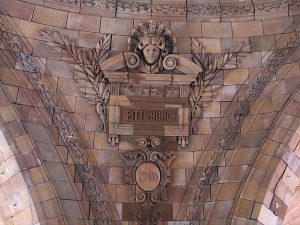 Every time I visit the Cultural District though, it’s either at dusk or at nighttime, and I am rushing to my seat for a performance. With Covid-19, and now the lack of musicals occurring, I discovered that it was such a joy just to walk around the Cultural District in the daytime.
Every time I visit the Cultural District though, it’s either at dusk or at nighttime, and I am rushing to my seat for a performance. With Covid-19, and now the lack of musicals occurring, I discovered that it was such a joy just to walk around the Cultural District in the daytime.On my recent walking tour, I saw more of the buildings and noticed how they related to one another in the built environment. I felt completely safe as I strolled down Penn Avenue and past a handful of sculptures and statues, even if several of them were shaped like eyes, watching me walk into the Agnes R. Katz Plaza. Unperturbed, I rested on one of those benches and looked closely at the facade of the Benedum Center for the Performing Arts. The lights, which illuminate the building at night, were turned off. For the first time, I could see how much work and intricacy was put into the pale terra cotta and tan brick building.
The terra cotta formed into the shape of a rising sun or a shell far above the windows, with even more ornamental patterns inside this arch. In modern buildings, there are not as many ornamented features, which tells me (and other alert observers) that many of the Cultural District buildings were created well before the 1950s and 1960s. Furthermore, during the day, I was able to read the message on the marquee of the Benedum: “Stay Safe and Healthy.” This made me smile, and it added a sense of relevance to the historic building, which otherwise could have been overlooked if driven by without knowledge of what life lives inside. The Cultural District is a great place to visit either at night or during the day, but whenever you go, I guarantee you will appreciate the beauty and welcoming aspect of the buildings and outdoor spaces.
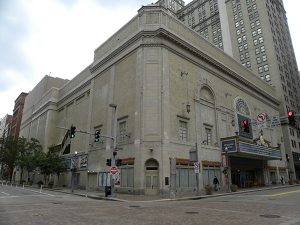 I next visited Market Square, nestled in the heart of Pittsburgh. Of all the places I have mentioned thus far, Market Square was by far the most bustling and alive. I was only able to stay a short time due to limited parking, but it was enough for me to get a good sense of how much it had to offer us: its history (laid out in 1784), delicious restaurants, and breezy, flowing urban design. This area gave off positive energy to everyone within its borders. But I wanted to know more about this area’s past.
I next visited Market Square, nestled in the heart of Pittsburgh. Of all the places I have mentioned thus far, Market Square was by far the most bustling and alive. I was only able to stay a short time due to limited parking, but it was enough for me to get a good sense of how much it had to offer us: its history (laid out in 1784), delicious restaurants, and breezy, flowing urban design. This area gave off positive energy to everyone within its borders. But I wanted to know more about this area’s past.At first, I was a bit confused as to where this history could be found, in a place so full of growth and new restaurants. Then I realized that if I looked closely, history was everywhere. The first piece of history I saw was a plaque labeled “Historic Landmark: Site of Bear Tavern (1827) Oyster House C. 1871-1971.” This was on the wall of the Original Oyster House. It was an average-looking brick building, but after this initial discovery, it did not take me long to find another restaurant in a historic building. Primanti Brothers, a true Pittsburgh classic, occupied a building constructed relatively soon after Pittsburgh’s Great Fire of 1845. It looked similar to the Oyster House building (they both were shorter buildings, with dentil molding under the eaves), which suggested to me that the Primanti Brothers building was constructed in a similar, but more ornamental, style (with window hoods, for example).
Market Square has nowhere near the feeling of historic grandeur that The Pennsylvanian or the Cultural District displays, but it is a beautiful space to remember the history of everyday Pittsburgh. While standing in the middle of the square, I felt like slowly turning my head to take everything in, that the public spirit and purpose of Market Square had never changed since it was laid out. It is a place for people to gather, eat good food, and enjoy each other’s company—whether that be in the Eighteenth, Nineteenth, Twentieth, or Twenty-first Centuries. It is a must-see for history and non-history lovers alike.
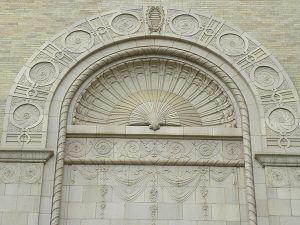 Between Market Square and the Cultural District was my next stop to see the Smithfield United Church of Christ. Designed by Henry Hornbostel and completed in 1926, it is located on very busy Smithfield Street. Parking was difficult to find. The building was draped in netting since the exterior needs to be restored, but that did not draw away from the beauty and history the church offers to the viewer.
Between Market Square and the Cultural District was my next stop to see the Smithfield United Church of Christ. Designed by Henry Hornbostel and completed in 1926, it is located on very busy Smithfield Street. Parking was difficult to find. The building was draped in netting since the exterior needs to be restored, but that did not draw away from the beauty and history the church offers to the viewer.My first thought upon seeing the church was about the way the building filled up every square inch of space allotted to it. Also, the church doors were wide and welcoming. It had a medieval look to it as well, with the open-work, aluminum spire at the top (which can only be really appreciated from a distance because of its height). In reading about the church, I learned this structure was designed in the eclectic Gothic Revival style. The church is famous for its series of stained-glass windows commemorating historical events and Pittsburgh scenes. I think stained glass is such a gorgeous feature of churches: the time and effort people have dedicated to creating it shows the importance of religious structures in our country’s history. There are a lot of churches in downtown Pittsburgh, which does make it hard to pick which one to explore next!
Rather than hunt for another religious structure in my guidebook, though, I decided to walk all the way to Point State Park. I enjoyed exploring the park the most. The vastness of the park makes it seem never-ending. Entering the park, I felt as if a little adventure was waiting just for me. I walked down the long footpath filled with a variety of people, from young families pushing strollers to men and women jogging. The park gave off positive and safe energy. After walking under the aptly named Portal Bridge (1961-63), my sightline opened up to a breathtaking view of the fountain and, in the near distance, the three rivers: the Monongahela, Ohio, and Allegheny. The foreground was anchored by a large, nicely mowed, grassy area where people were having picnics and throwing frisbees. The rivers were beautiful to look at, but knowing their past made them all that more lovely.
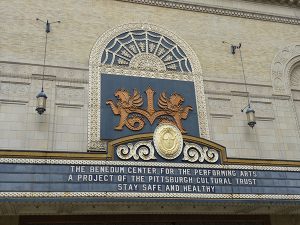 These three rivers were crucial in the French and Indian War (1754-1763), which became a global conflict between England and France that was known as the Seven Years’ War (1756-1763). Whoever controlled trade in the Ohio Country, controlled settlement further west, and the Point, where the Ohio River began, was of strategic importance. Because these rivers were so important for maintaining control over the region, I thought that there must be some sort of fortification here, right? Yep, the very next thing I noticed was a reconstructed bastion of the British Fort Pitt, and nearby, the outline of the French Fort Duquesne. Although the forts were no longer standing, the Fort Pitt Block House has survived for 257 years and is open to the public. At school, the Seven Years War and Pittsburgh’s role in it are discussed so students are familiar with the names of these two forts. Still, seeing the outlines of the actual forts located at the Point where the three rivers meet made the whole conflict more real.
These three rivers were crucial in the French and Indian War (1754-1763), which became a global conflict between England and France that was known as the Seven Years’ War (1756-1763). Whoever controlled trade in the Ohio Country, controlled settlement further west, and the Point, where the Ohio River began, was of strategic importance. Because these rivers were so important for maintaining control over the region, I thought that there must be some sort of fortification here, right? Yep, the very next thing I noticed was a reconstructed bastion of the British Fort Pitt, and nearby, the outline of the French Fort Duquesne. Although the forts were no longer standing, the Fort Pitt Block House has survived for 257 years and is open to the public. At school, the Seven Years War and Pittsburgh’s role in it are discussed so students are familiar with the names of these two forts. Still, seeing the outlines of the actual forts located at the Point where the three rivers meet made the whole conflict more real.I also visited the Fort Pitt Museum, whose exhibitions and gift shop were engaging and enlightening. When I left the museum, it was getting dark, so I decided to head back. I walked a different way, though, closer to the river, and noticed there were plenty of bikers on this paved path, which showed me the huge variety of things you can do in Point State Park. By the time I reached home, I was definitely worn out from all the walking, but it was worth it! Point State Park is the type of place where you can return again and again and each time, discover more about Pittsburgh, both past and present.
The next time I found room in my schedule to explore downtown Pittsburgh, I took time to learn more about the Omni William Penn Hotel (Janssen & Abbott, architects, 1914-16; Janssen & Cocken, architects, 1926-29; Joseph Urban [New York], 1929). I entered the hotel from Mellon Square (itself a quiet respite from the city’s bustle) along William Penn Way. Above the entrance is a canopy with the inscription “William Penn Hotel,” along with different emblems, such as the Penn family crest. Beneath the canopy is bellhops who are there at the ready to take luggage, park cars and help customers. They were dressed in uniforms from a bygone era. Between the architecture of the hotel and the attendants’ attire, I was immediately pulled back into a different time. As the bellhop pushed the revolving door for me and I walked into the “swanky” lobby, I felt like I was a 1920s heiress who was staying at the hotel. Sparkling chandeliers hung from the ceiling, large arches provided glimpses into the branching hallways, and a wall clock ticked away the time. The lobby’s stateliness reminded me of the clocks found in another type of historic Pittsburgh landmark—our grand train stations. I walked through the lobby, passing the beautiful historic restaurant, and traveled down the first hallway I saw. The hallway was filled with history. There were pictures, documents, paintings, and sculptures in glass cases that all related to the founding of Pittsburgh and to the opening of the William Penn Hotel.
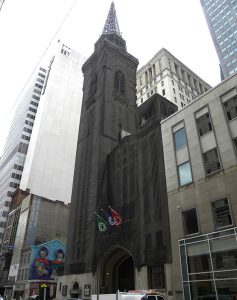 Looking up, I noticed a sign hanging from the ceiling saying “Speakeasy,” with an arrow pointing to the lower level of the hotel. The word “speakeasy” rang a bell in my mind from history class as a place where alcohol was illegally sold during Prohibition in the 1920s. I wanted to know more, so I found the closest stairwell and quickly descended. Then, I dashed down the hall past the William Penn Ballroom and spotted two doors with “Speakeasy” written on them. I was disappointed to find that I could not open the doors because the room, which is a working bar, was closed until later that evening. Nonetheless, I was able to peer through the green-tinted windows of the door and observe an almost perfectly replicated speakeasy of the 1920s. I found it so neat that the room continued to serve its original purpose. I took some photos and explored the surrounding area a bit more before deciding I had definitely achieved my purpose in visiting the hotel, which was to explore its history and appreciate its present beauty. It is a charming hotel for tourists, and a must-see for Pittsburgh residents: it really does make you feel like you are living in a completely different time, with a far more luxurious life!
Looking up, I noticed a sign hanging from the ceiling saying “Speakeasy,” with an arrow pointing to the lower level of the hotel. The word “speakeasy” rang a bell in my mind from history class as a place where alcohol was illegally sold during Prohibition in the 1920s. I wanted to know more, so I found the closest stairwell and quickly descended. Then, I dashed down the hall past the William Penn Ballroom and spotted two doors with “Speakeasy” written on them. I was disappointed to find that I could not open the doors because the room, which is a working bar, was closed until later that evening. Nonetheless, I was able to peer through the green-tinted windows of the door and observe an almost perfectly replicated speakeasy of the 1920s. I found it so neat that the room continued to serve its original purpose. I took some photos and explored the surrounding area a bit more before deciding I had definitely achieved my purpose in visiting the hotel, which was to explore its history and appreciate its present beauty. It is a charming hotel for tourists, and a must-see for Pittsburgh residents: it really does make you feel like you are living in a completely different time, with a far more luxurious life!My travels in downtown Pittsburgh to visit The Pennsylvanian, the Cultural District, Market Square, Smithfield United Church of Christ, Point State Park, the Omni William Penn Hotel, and other sites were rewarding experiences that showed me how history is present everywhere. The beauty in visiting historical landmarks is not just about enjoying the architecture of the buildings, but also about being in the place where significant events have occurred. This self-guided tour taught me that history is truly in every part of my city—from every hotel to every park.
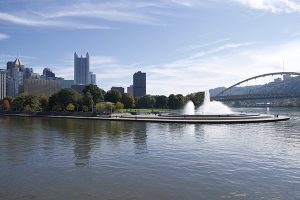 I highly encourage everyone to take part in a similar walking tour. You’ll learn to appreciate just how rich we are in Pittsburgh, thanks to the efforts by many to preserve architectural landmarks and local history! During my walking tours, I did not spend even a single penny to visit any site, with the exception of a modest admission fee for the Fort Pitt Museum, which also shows just how affordable it can be to get out and explore your community. There is one way you can spend money, though, that will benefit the sites and Pittsburgh as a whole. Most historic buildings are either underfunded or in need of restoration or constant repairs for their upkeep, so donations can help these sites survive. You also can show some love for our city’s past and present by taking a historic tour this summer. I guarantee you will not be disappointed!
I highly encourage everyone to take part in a similar walking tour. You’ll learn to appreciate just how rich we are in Pittsburgh, thanks to the efforts by many to preserve architectural landmarks and local history! During my walking tours, I did not spend even a single penny to visit any site, with the exception of a modest admission fee for the Fort Pitt Museum, which also shows just how affordable it can be to get out and explore your community. There is one way you can spend money, though, that will benefit the sites and Pittsburgh as a whole. Most historic buildings are either underfunded or in need of restoration or constant repairs for their upkeep, so donations can help these sites survive. You also can show some love for our city’s past and present by taking a historic tour this summer. I guarantee you will not be disappointed! -
Students and Teachers Praise New Series of Virtual Tours

Third-grade students from Pittsburgh Greenfield created an animated PowerPoint (excerpts above) thanking PHLF for providing a series of virtual tours through its “Building Pride, Building Character” EITC program during the pandemic.
Teachers from 13 Pittsburgh Public Schools augmented their classroom curricula (Grades 3 through 5, primarily) with a series of educational videos created by our organization between January and early June.
Louise Sturgess, our organization’s education advisor, narrated the series. Randall Coleman produced ten of the videos, with assistance from sound technician Tyler Vietmeier, and Chris Ivey produced one of the videos, with assistance from William Xeno Hurst.
The video series was based on field trips and in-school presentations that we have created previously through our “Building Pride, Building Character” program, made possible through the Pennsylvania Educational Improvement Tax Credit (EITC) Program.
As one Pittsburgh Public School educator responded after participating in the “Building Pride, Building Character Program”: “You didn’t miss a beat. Everything we have seen and heard in person was included [in these virtual tours and video resources]. You did an amazing job of bringing the experience to my students, and they completely enjoyed and appreciated it. They cannot wait to go in-person next school year!”
Our most popular “Building Pride, Building Character” field trips have been converted into a series of educational videos. Each video is approximately 20 minutes long. Louise Sturgess, PHLF’s education advisor, is the narrator. She is joined by notable representatives who are knowledgeable about each landmark. For example, County Executive Rich Fitzgerald welcomes students to the Allegheny County Courthouse. James Hill, the executive assistant to the Mayor, welcomes students to the City-County Building. Denise Turner, acting chief executive and board president of August Wilson House, welcomes students to the playwright’s childhood home in the Hill District.
The “Pittsburgh People and Places” video series features a trolley tour through Downtown Pittsburgh and visits to the Dollar Bank Heritage Center, August Wilson African American Cultural Center, August Wilson House, and Freedom Corner.
The “Building Pride, Building Character” video series features the City-County Building, Allegheny County Courthouse, Fort Pitt Museum, Fort Pitt Block House, and Duquesne Incline. Each landmark is associated with a group of “character-building” words, and students are encouraged to develop those traits within themselves.
Students may also explore Pittsburgh’s history virtually through “The Bigham House on Mt. Washington: A Pittsburgh Connection to the Underground Railroad.”
One more video, “Introducing Pittsburgh,” shares the history of Pittsburgh through nine historic images and helps students appreciate the value of diversity in the built environment.
Each of these videos is now viewable publicly on PHLF’s YouTube channel “Renewing Communities.” Although the videos were designed for students in grades three through five, there is valuable information for people of any age.
Click here for a complete list of EITC donors who underwrote our virtual programming with the Pittsburgh Public Schools this academic year. We thank all our donors who contributed to PHLF’s “Building Pride, Building Character” educational program, made possible through the Pennsylvania Department of Community and Economic Development’s Educational Improvement Tax Credit (EITC) program.
-
Students Learn from Video Tour Series of African American Landmarks
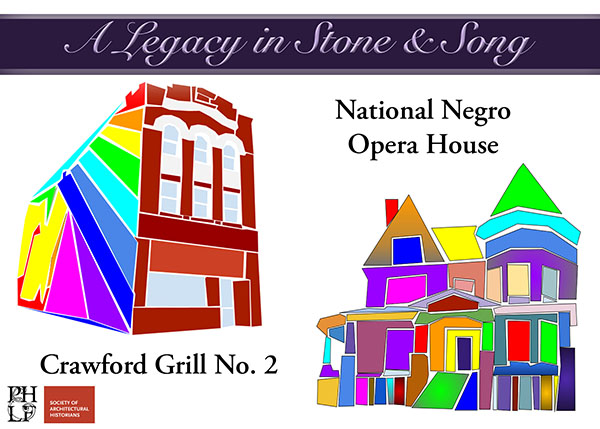
Students from Pittsburgh Westinghouse and Faison are creating works of art and music inspired by their learning during a video tour of African American landmarks in Pittsburgh. These drafts of student digital art show the National Negro Opera House and Crawford Grill No. 2.
In February 2021, the Society of Architectural Historians awarded our organization an American Architecture and Landscape Field Trip Grant for a new educational program, “A Legacy in Stone & Song.”
The grant leveraged additional funding support from the McSwigan Family Foundation Fund of The Pittsburgh Foundation, and the Gailliot Family Foundation, which will enable the program to continue into the 2021-22 academic year. This spring, students the Westinghouse and Faison Pittsburgh Public Schools had the opportunity to virtually explore the architecture and history of the National Negro Opera House in their Homewood neighborhood, as well as three other sites of significance in Pittsburgh’s African American history: the New Granada Theater, Crawford Grill No. 2, and August Wilson House.
Through a video field trip narrated by Sarah Greenwald, PHLF’s co-director of education, and knowledgeable community representatives, the story of each of these places came alive for students. After watching the video, students began working with their teachers, area artists, and musicians to complete a classroom-based creative project inspired by the history and culture embedded in these landmarks.
Their work will continue into the next academic year when students will have more time and resources to add their artistic voices to those who have made these historic places so important to Pittsburgh’s African American legacy.
“I am incredibly grateful to our funders and educators who have gone above and beyond supporting us while we work to enrich student learning during an incredibly difficult academic year. I look forward to continuing our collaboration with these students and educators,” said Sarah.
Our education programs depend on your support. Click here to make a tax-deductible contribution.
-
“Building Pride, Building Character” Encourages Pride of Place and Person
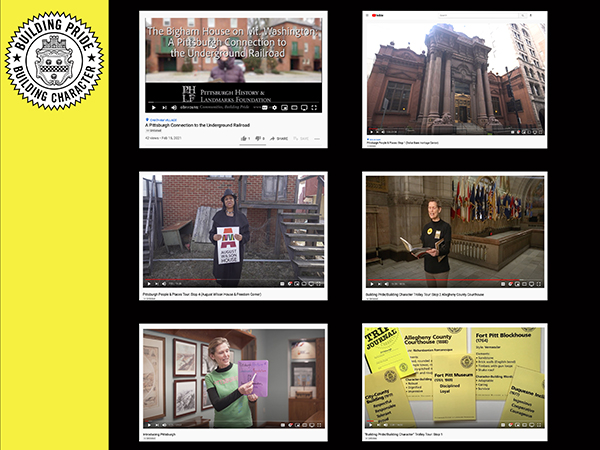
Our “Building Pride, Building Character” EITC program shares the Pittsburgh region’s rich architecture and history with students through educational field trip videos like those pictured above.
Despite the challenges educators and students faced this school year, they were still able to connect to inspirational and historic Pittsburgh landmarks through PHLF’s Building Pride, Building Character EITC program. This year, we converted our field trips to a series of educational videos. Three more videos in the “Pittsburgh People and Places” series were released at the end of May featuring a trolley tour through Downtown Pittsburgh, the August Wilson African American Cultural Center, and August Wilson House and Freedom Corner. Additionally, two educational videos in our “Building Pride, Building Character” Trolley Tour were released featuring the City-County Building and Allegheny County Courthouse.
Three additional videos in that series will be released in early June featuring the Fort Pitt Museum, Fort Pitt Block House, and Duquesne Incline.
“I hope these virtual tours help fill your remaining days with some of the learning about Pittsburgh––and fun––that we all used to experience on our in-person field trips,” wrote PHLF’s Education Advisor Louise Sturgess in an e-mail to Pittsburgh Public School teachers.
Previously released videos include “Introducing Pittsburgh,” which shares the history of Pittsburgh through nine historic images and helps students appreciate the value of diversity in the built environment. Also released in February and March were “The Bigham House on Mt. Washington: A Pittsburgh Connection to the Underground Railroad,” and the “Dollar Bank Heritage Center” video, the first stop on our virtual “Pittsburgh People & Places” field trip.
Educator feedback has been overwhelmingly positive:
- My students are watching “Introducing Pittsburgh” with me (again). I asked them to watch during our half day. This is great! (I had one boy tell me he watched it three times––and he loves it!)
- [Introducing Pittsburgh] supports our Geography/history curriculum. The students learn about the history of Pittsburgh and how it developed. Many students have not been to many of the areas mentioned and shown in the video, so this virtual trip gave them a peek at our city. Some students are new to Pittsburgh this year, and due to the pandemic have not had the chance to explore. They expressed interest in visiting the places mentioned this summer. We also have a large English Language Learners group. They have not been to many of the places as well. Thank you so much for this production. If you do have others, we look forward to viewing those.
- Thank you so much for this wonderful resource!
- This is FANTASTIC! Thank you!
- This video supplemented our social studies curriculum by adding a clear picture of what it was like to be on the Underground Railroad. The students were amazed that we have an original historic landmark in our own hometown that was part of the actual railroad. I truly appreciated the time and effort you have put into making that video.
“I am so pleased that we have been able to continue offering our Building Pride, Building Character EITC program. Thanks to our corporate sponsors and dedicated Pittsburgh Public School teachers, students have continued learning about Pittsburgh through its historic landmarks,” said Sarah Greenwald, co-director of education.
Click here for a complete list of donors who are underwriting our virtual programming with the Pittsburgh Public Schools through mid-June. We thank all our donors who contributed to PHLF’s “Building Pride, Building Character” educational program, made possible through the Pennsylvania Department of Community and Economic Development’s Educational Improvement Tax Credit (EITC) program. Contributions from the McSwigan Family Foundation Fund of The Pittsburgh Foundation and from the Gailliot Family Foundation also helped underwrite video production.
-
Committee Selects 2021 Landmarks Scholarship Winners
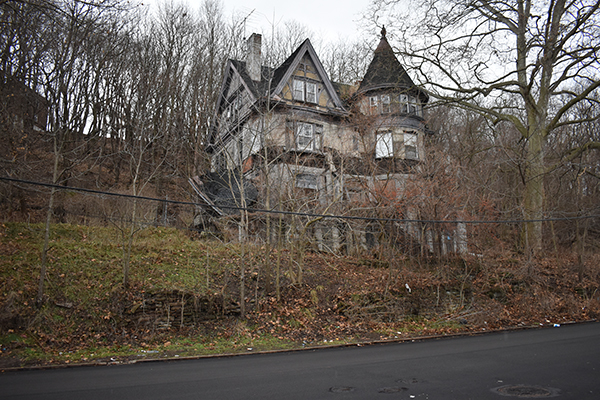
One of the 2021 Landmarks Scholarship recipients focused his application essay on the National Negro Opera House located in Homewood, which was last year listed as one of the 11 Most Endangered Historic Places by the National Trust for Historic Preservation.
Our Landmarks Scholarship, now in its twenty-third year, connects college-bound high school students who live in Allegheny County, have a 3.25-grade point average or above, are involved in their community, and care deeply about the Pittsburgh region with the resources to support their continuing education. The Scholarship Committee recently announced this year’s award recipients with the goal of helping as many young people as possible. “Just as we did last year, we really tried to be a ray of light and hope in a high-school students’ challenging experience during 2020 and 2021,” said David Brashear, Committee chair and founder of our Scholarship program.
Our Scholarship Committee is pleased to announce the following winners:
2021 Scholarship Recipients
(Each scholarship has a maximum value of $6,000 and is payable over a four-year period to the recipient’s college/university student account. The scholarship is for book and tuition expenses.)
- Sage Arnold (Pittsburgh Allderdice /University of Rochester)
- Drew Young (Oakland Catholic/South Carolina Agricultural and Technical State University)
- Eric Gary (Kiski School/Allegheny College)
2021 Honorable Mention Recipients
(This is a one-time payment of $250 to the recipient’s college/university student account.)
- Ilham Ariouat (Bethel Park High School/Chatham University)
- Natalie Beinlich (Elizabeth Forward High School/Washington and Lee University)
- Ryan Boyle (McKeesport Area Senior High School/University of Florida)
- Sylvia Donahue (West Allegheny High School/Penn State University)
- Elijah Duckworth (North Allegheny Senior High School/Undecided)
- Gil Isaac Gabriel (City Charter High School/ West Chester University of Pennsylvania)
- Graham Herzig (Avonworth High School/Penn State University)
- Yunshu Li (North Allegheny Senior High School/Carnegie Mellon University)
- Gwendolyn Nace (Quaker Valley High School/Pratt Institute)
- Benjamin Stalder (Aquinas Academy/University of Richmond)
Congratulations to all!
As part of the process, applicants were asked to write an essay about a place in Allegheny County that is important to them. “The students’ insights into the landmark places of Allegheny County are incredibly moving; they demonstrate that even during difficult times, connections to our community landmarks are what anchor and sustain us,” said co-director of education Sarah Greenwald.
Excerpts from some of the essays include the following insights:
- Frick Park: “Although my time in Frick Park is most often spent by myself, I never feel alone knowing the beautiful natural history of the woods. […] The centuries of history embedded in the soil of Frick Park teach lessons about the importance of maintaining balance in tumultuous times.”
- August Wilson African American Cultural Center: “The building is a pure work of art. It was purposefully constructed on a corner in downtown Pittsburgh. The exterior of the building was inspired by ships that transported Swahili culture from West Africa. Additionally, the exterior material is composed of metal, stone, and glass which provides an illusion of movement and freedom. […] I identify with its position on the corner in the middle of downtown because it signifies a crossroad––which I feel as a senior in high school, about to transition to a college freshman.”
- National Negro Opera House: “Through all the years of wear and tear it is still standing. I believe in my heart that a miracle is going to take place and the historically important building will receive the needed funding and can be saved for all to see.”
“As one recipient so eloquently wrote: ‘I love helping kids. I know when we start them young, we can plant a seed and watch them grow.’ Our Scholarship Program does just that by supporting these young leaders and being an organization that gives them a way to always re-connect with and value their hometown,” said Louise Sturgess, education advisor. “We are grateful to the Brashear Family, to committee members, and to other donors who so generously support our annual Scholarship Program.”
-
Joint Jewish Education Program Explores Landmark Buildings

JJEP’s Landmark Art: Inspiration from Our Buildings course explored the oft-hidden details in our landmark buildings that reflect our values––beauty, spirituality, teamwork, social responsibility, and more.
Pittsburgh’s Joint Jewish Education Program (JJEP), which included an elective class titled Landmark Art: Inspiration from Our Buildings, concluded in April. The class, an exploration of landmark buildings was taught by Sarah Greenwald, our organization’s co-director of education. The students in the program came from Congregations Beth Shalom and Rodef Shalom in Pittsburgh’s Squirrel Hill and Oakland neighborhoods, respectively.
Sarah guided students as they studied the foundations of architecture, learned to “read” values reflected in artistic symbols found on and in our historic buildings, created art inspired by these buildings, and discussed the importance of historic preservation. As one student so eloquently stated: “If it is made with care, and has its own unique features, it [a building] can be art.”
“Seeing these students grow to appreciate the landmark buildings of Pittsburgh’s Jewish community was a highlight of this course,” Sarah said. “I was impressed with how deeply students used this elective to think about the historic buildings around them and understand how our buildings are works of art and how they reflect our values and carry them into the future.”
As part of this course, students were asked to share their thoughts on historic preservation: Is it important? Why or why not? Some of their insights include:
“Historic preservation is important. It [The historic structure] could educate people, house people, serve as a memorial. Like Pittsburgh’s bridges, we have a lot of bridges [and] we are known for our bridges, so we should save them. They are a part of who we are.”
“They [our buildings] are a part of history. It is important to save them. For example, if a movie theater survived a nuclear war, it would tell people who survived about the past.”
Students worked diligently from home during this virtual course, completing several art-based activities, and taking virtual explorations to jumpstart their learning. “I look forward to exploring the artistry of Pittsburgh’s landmark buildings in person, next time, with these students and others,” said Sarah.
-
“Building Pride, Building Character” Program Nurtures Citizenship Skills
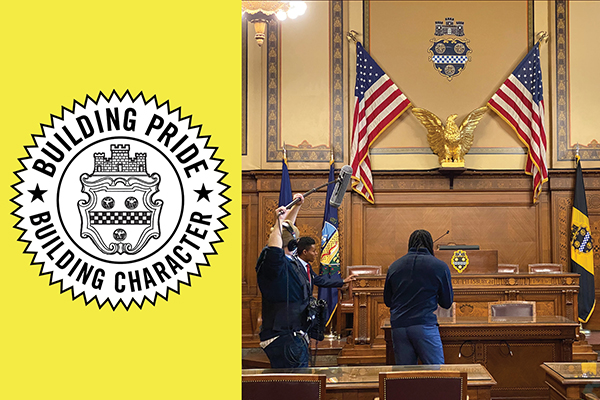
This year, the “Building Pride, Building Character” program is being offered in a virtual format, teaching Pittsburgh Public School students about Pittsburgh’s history and architecture, and the people who work to improve our communities. Pictured here are videographer Randall Coleman of Reddvision and sound technician Tyler Vietmeier filming James Hill (Special Assistant to Mayor Bill Peduto) sharing the historic beauty and function of Pittsburgh’s City Council Chambers with students.
As part of our Building Pride, Building Character EITC program, Pittsburgh Public School students from Dilworth met virtually on March 12, with City Councilwoman Deborah Gross to learn more about city government and to discuss the strengths and weaknesses of their neighborhood.
After a 30-minute conversation, Dilworth teachers Stephanie Hornick, Cory Herschk, and Lauren Freeman, sent thank you notes created by the students to Councilwoman Gross and noted that “you gave us lots of great things to talk about during Social Studies class.”
“It was inspiring to hear third-grade students sharing their concerns about vacant buildings, roads, and green spaces in their neighborhoods,” said Co-director of Education Sarah Greenwald. “They clearly know and value their community and want to take care of it––and that is a primary goal of our EITC program.” This was the second virtual meeting between third-grade students and City Council representatives: students from Pittsburgh Roosevelt met with Blake Plavchak, Councilman Coghill’s Chief of Staff, on February 23.
We also recently released another educational video for use in third- and fourth-grade classrooms. The “Dollar Bank Heritage Center” video is the first stop on our virtual Pittsburgh People & Places field trip. “Through exhibits and artifacts housed in the remarkable Dollar Bank Heritage Center, we introduce the art of writing biographies to fourth-grade students,” said Education Advisor Louise Sturgess. “We especially thank Dorothy Spangler of Dollar Bank for providing historical images and information for our use.”
Videographer Randall Coleman and Tyler Vietmeier, a sound technician, are in the process of editing six more videos; three more architectural landmarks will be filmed in April, with editing to follow.
We thank S&T Bank for recently contributing to PHLF’s “Building Pride, Building Character” educational program, made possible through the Pennsylvania Department of Community and Economic Development’s Educational Improvement Tax Credit program. Click here for a complete list of donors who are underwriting our virtual programming with the Pittsburgh Public Schools through mid-June.

